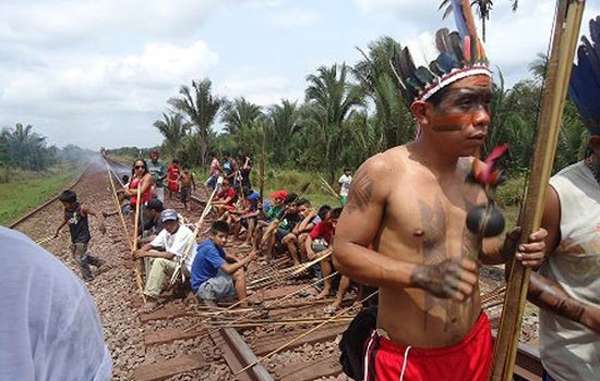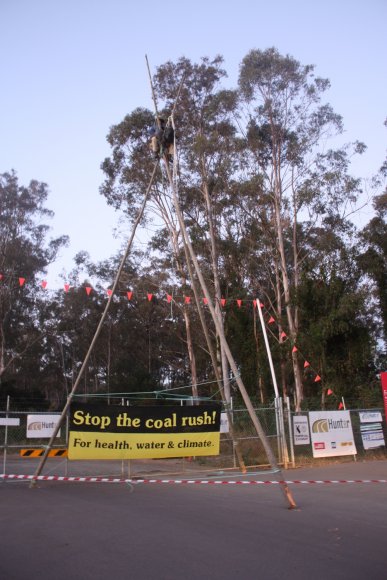
by Deep Green Resistance News Service | Oct 6, 2012 | Colonialism & Conquest, Indigenous Autonomy, Mining & Drilling, Obstruction & Occupation
By Survival International
A protest involving Earth’s most threatened tribe, the Awá, has forced the world’s largest iron ore mine to suspend operations along its main railway line.
On Tuesday, hundreds of Indians including the Awá, took to the tracks of Vale’s Carajás railway to voice their opposition to Brazilian government plans that could weaken their land rights, if legalized.
The demonstration follows months of anger surrounding a draft text called Directive 303, which prohibits the expansion of indigenous territories.
The government has refused to scrap the proposed directive, despite it violating national and international laws by suggesting certain projects can be carried out on Indian land without proper consultation.
Frustrations spilled over on Tuesday, with several different tribes uniting to demand that their land rights are respected.
The blockade is the latest in a string of controversies to involve mining giant Vale, whose railway borders the territory of the Awá.
Last month, a judge reversed a ruling that had stopped the company from doubling its railway line to increase production.
The decision was a blow for the Awá, who blame the railway for bringing thousands of invaders into their lands and scaring off the animals they hunt.
Survival’s Director Stephen Corry said today, ‘If Brazil wants to lead the way and show the world that it respects its indigenous peoples, it should not be entertaining the harmful propositions of a handful of rural lobbyists. This protest shows that for tribes like the Awá, land rights are make or break.’
From Survival International: http://www.survivalinternational.org/news/8722

by Deep Green Resistance News Service | Sep 5, 2012 | Mining & Drilling, Obstruction & Occupation
By Rising Tide Australia
Activists entered the Hunter 8 Alliance compound at Rutherford before dawn today, erecting a wooden tripod to block access to the site, which is part of a Federally funded project to increase coal haulage capacity in the Hunter Valley. Activist Ned Haughton scaled the 10 metre high structure, where he remained for the next five and a half hours. Haughton has now been arrested, and will be charged with obstruction.
Steve Phillips, spokesperson for protest organisers Rising Tide, said: “This railway construction project is designed purely for the benefit of coal corporations, yet it is being paid for with taxpayers money.”
“Why are taxpayers dollars being handed over to rich mining corporations, in order to prop up a polluting industry that is destroying human health and the environment?”
“There is a coal rush under way in NSW, and public health, waterways, ecosystems, and the global climate are under assault. Massive coal mine projects, coal haulage projects, and coal port projects are in the pipeline. If all these projects go ahead, the consequences will be devastating.”
Today’s protest follows two consecutive days of community direct action against the Boggabri mine in the Gunnedah Basin – the coal industry’s “new frontier”. A major expansion of the Boggabri coal mine was approved by the NSW Government in July despite huge ecological impacts and overwhelming community opposition.
“We call on State and Federal Governments to abandon their infatuation with mining companies, and their addiction to fossil fuels. It’s time to take a stand and stop this coal rush before it’s too late.”
Key facts.
- The Maitland to Minimbah Third Track project is being constructed by Hunter 8 Alliance, which is a consortium of engineering company GHD, construction company John Holland, and the Federally owned Australian Rail Track Corporation.
- The objective of the project is to lift coal haulage capacity on the Hunter rail corridor to 200 million tonnes per annum. It includes construction of 23km of new rail track, and reconditioning of 9km of existing track.
- The Federal Government granted $114 million, through the ARTC, to the project.
From Rising Tide Australia
by Deep Green Resistance News Service | Jul 2, 2012 | Colonialism & Conquest, Indigenous Autonomy
By Gethin Chamberlain / The Guardian
A fierce row has broken out over a controversial plan to drive a road through pristine Amazon rainforest, imperilling the future of some of the world’s last uncontacted tribes.
The 125-mile (200km) road would pass through the Alto Purús national park in Peru, connecting a remote area to the outside world but opening up the most biologically and culturally important area of the upper Amazon to logging, mining and drug trafficking. Opponents of the plan fear it will threaten the existence of uncontacted tribes such as the Mashco-Piro. The first detailed photographs of members of the tribe made headlines around the world earlier this year after they were spotted on a riverbank.
The majority indigenous population of the region appears to be largely united in its opposition to the road, which would run parallel to the Brazilian border, connecting the towns of Puerto Esperanza and Iñapari. Conservationists warn it would cause irreparable harm to the environment and the area’s people.
But the road has the support of many mixed-race settlers – or mestizos – who make up roughly one fifth of the region’s population. With the Alto Purús currently accessible only by plane, they believe that the road would improve their quality of life, bringing lower prices for fuel and food and creating profitable development opportunities.
The campaign to build the road has been led by an Italian missionary, Miguel Piovesan, who claims that indigenous people are being kept isolated and denied the chances for development available to the rest of the population. He first proposed the road in 2004, around the time the Peruvian government announced that the Alto Purús was to become the country’s largest national park.
Piovesan’s plan’s met with little initial enthusiasm, but his long and determined campaign, using his own radio station and parish website, has been so successful that the country’s Congress is now due to debate a bill to allow construction to start. Piovesan has been scathing about his opponents, particularly international organisations such as Survival International and the WWF, which he accuses of profiting from keeping the tribes in isolation.
“These international organisations gain money because they present themselves as the saviours of the Indians, this is what it’s all about. So if the Indians evolve, they [the NGOs] lose their business,” he said on a recent radio show. Last week he told the Observer that the reality was that the indigenous people were being kept in a condition of “captivity and slavery incompatible with the true ecology”.
But Piovesan’s opponents suspect that he is more interested in gaining access to potential converts for his church. Reports from Peru say that he has denied the existence of the uncontacted tribes. The main indigenous organisation in Puerto Esperanza, Feconapu, has demanded that the Vatican remove the priest, accusing him of insulting and humiliating the native population.
One indigenous leader, Julio Cusurichi, warned that building the road would amount to “ethnocide” of the uncontacted tribes. According to the last census, in 2007, there are only about 3,500 people living in the region, including eight known tribes and an unknown number of uncontacted Indians living in the Madre de Díos territorial reserve. The 6.7m-acre national park is also home to wildlife including jaguar, scarlet macaw and giant river otter.
The Upper Amazon Conservancy, which works with the indigenous population, has been one of the most vocal critics of the road. Its director, Chris Fagan, accused the road’s supporters of short-sighted greed and said the majority of the population were vehemently opposed.
“They depend on the forest and rivers for daily sustenance. They see the highway as just the latest example of mestizo greed and exploitation – of rubber, their religion, animal skins, mahogany, and now a highway accessing their homelands,” he said. “It will ruin one of the wildest and culturally important places on Earth. Will reason or greed prevail?”
Read more from The Guardian: http://www.guardian.co.uk/world/2012/jul/01/amazon-highway-peru-tribes-risk

by Deep Green Resistance News Service | May 3, 2012 | Obstruction & Occupation
By Steve Lyttle / Charlotte Observer
Six people were arrested Thursday morning in Catawba County after a group of protesters from Greenpeace and three other organizations blocked a train from entering Duke Energy’s steam-powered plant in Catawba County by chaining themselves to the tracks.
The group aimed the protest at Duke Energy, for its use of coal-powered plants, and at technology giant Apple. Leaders of the action said they are protesting Apple because it is using Duke Energy power for the expansion of its data center at Maiden in Catawba County.
“The group was able to stop the train from passing by,” said Molly Dorozenski, a Greenpeace spokesperson.
The Catawba County Sheriff’s Office confirmed that arrests were made. According to reports from the scene, four people who had chained themselves to the tracks were taken into custody, along with two others at the scene.
The action came at the same time as Greenpeace demonstrators were outside Duke Energy’s corporate headquarters in Charlotte’s uptown, protesting during the company’s shareholders meeting.
Dorozenski said the incident began Thursday morning when a train carrying coal arrived at the Marshall Steam Station. She said four activists chained themselves to the tracks, to prevent the train from delivering coal. She said other protesters put the Apple logo on train cars, to show the group’s belief that Apple is profiting by Duke Energy’s use of coal.
Greenpeace contends the use of coal is creating an environmental hazard, and that coal mining is damaging to the ecology of the Appalachia region.
Joining Greenpeace in blocking the train were members of Radical Action for Mountain People’s Survival (RAMPS), Katuah Earth First! and Keepers of the Mountains Foundation, according to Greenpeace.
“Duke is using data center expansion in North Carolina, like Apple’s, to justify reinvesting in old coal-fired power plants and even worse — as an excuse to build new coal and nuclear plants,” said Gabe Wisnieweski, Greenpeace’s USA Coal Campaign director.
“The climate and communities throughout Appalachia and North Carolina are paying the price for Apple and Duke’s short-sighted decisions,” he added.
Read more from The Charlotte Observer:



